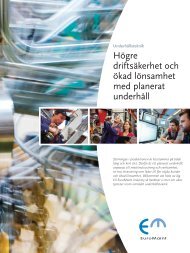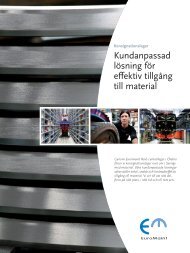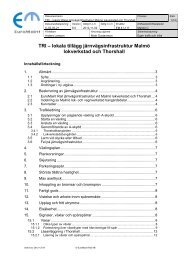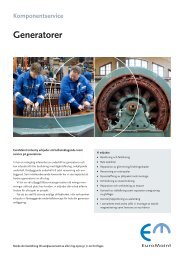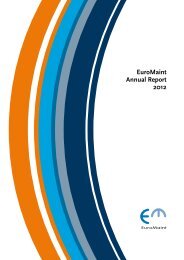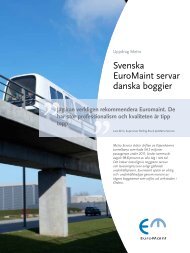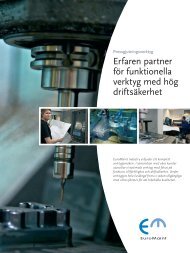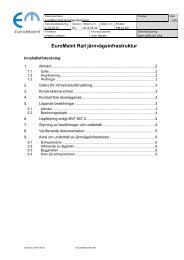Annual Report 2006 (pdf) - EuroMaint Rail
Annual Report 2006 (pdf) - EuroMaint Rail
Annual Report 2006 (pdf) - EuroMaint Rail
Create successful ePaper yourself
Turn your PDF publications into a flip-book with our unique Google optimized e-Paper software.
E u r o M a i n t A n n u a l R e p o r t 2 0 0 6<br />
Note 1<br />
Accounting principles Contd.<br />
Write-downs<br />
Assets with an indefinite useful life are not depreciated/amortised but<br />
tested annually to determine any write-down requirement. The assets<br />
which are depreciated/amortised are assessed in terms of decrease<br />
in value whenever an event or a change in circumstances indicates<br />
that the carrying amount may not be recoverable. A write-down is<br />
carried out for the amount by which the asset’s carrying amount<br />
exceeds its recoverable amount. The recoverable amount is the higher<br />
of an asset’s fair value less selling expenses, or its value in use. On<br />
determining the write-down requirement, the assets are grouped at<br />
the lowest levels at which there are separate, identifiable cash flows<br />
(cash generating units). Goodwill is tested annually to identify any<br />
write-down requirement and is recognised at cost less accumulated<br />
write-downs.<br />
Financial instruments<br />
Financial instruments recognised as assets in the balance sheet<br />
include cash equivalents, accounts receivable, derivatives and other<br />
receivables. Those recognised as liabilities include accounts payable,<br />
borrowings, derivatives and other liabilities.<br />
A financial asset or financial liability is recognised in the balance<br />
sheet when the company becomes party to the instrument’s contractual<br />
terms. Accounts receivable are recognised in the balance sheet<br />
once an invoice has been sent. Liabilities are recognised once the<br />
counterparty has completed its task and there is a contractual obligation<br />
to pay, even though an invoice may not yet have been received.<br />
Accounts payable are recognised once the invoice has been received.<br />
A financial asset is excluded from the balance sheet once the<br />
contractual rights have been realised, have expired or the company<br />
has lost control over it. The same applies for part of a financial asset.<br />
A financial liability is removed from the balance sheet once the obligation<br />
in the contract has been fulfilled or has in some other way been<br />
extinguished. The same applies for part of a financial liability.<br />
Financial assets<br />
Acquisitions and sales of financial assets are reported on the business<br />
day, i.e. the day on which the company commits to acquiring or<br />
selling the asset.<br />
Borrowing<br />
Loans are initially recognised at the loan amount and are subsequently<br />
entered at the loan amount less reductions. Borrowing is classified as<br />
a current liability if the payment of the liability will be made within 12<br />
months of the balance sheet date.<br />
Derivative instruments<br />
The Group uses derivative instruments to secure parts of its exposure<br />
to currency risks in ongoing payment flows. Management is in<br />
accordance with the financial rules established by the Board. Hedge<br />
accounting is not applied, instead all derivatives are categorised as<br />
financial assets and liabilities valued at fair value through the income<br />
statement. This means that the change in value of the derivatives is<br />
recognised in the income statement under financial items. Derivatives<br />
with positive values are entered as assets and derivatives with<br />
negative values are entered as liabilities. Fair value is established by<br />
obtaining the costs or revenue which would have arisen if the contract<br />
had expired on the balance sheet date.<br />
Inventories<br />
Material stores and finished goods inventories are valued at the lower<br />
of cost or net selling price. The Group applies the first-in, first-out<br />
method (FIFO). The net selling price is the estimated selling price in<br />
operating activities less applicable variable selling expenses.<br />
Accounts receivable<br />
Accounts receivable are reported at the invoiced amount less any reserve<br />
for decrease in value. A reserve for decrease in value of accounts<br />
receivable is set up when there is objective proof that the Group will<br />
not be able to receive all amounts due in accordance with the original<br />
terms of the receivables. The size of the reserve is the difference between<br />
the asset’s carrying amount and the value of assessed future cash<br />
flows. The decrease in value is reported in the income statement.<br />
Cash and cash equivalents<br />
Cash and cash equivalents include cash and bank balances. In<br />
the balance sheet, the bank overdraft facility utilised is entered as<br />
borrowing under current liabilities.<br />
Income tax<br />
The tax burden is affected by appropriations and other tax adjustments<br />
made in each company. The tax rate used is 28%. Deferred tax is<br />
recognised in its entirety on all temporary differences comprising<br />
the difference between the tax base for assets and liabilities and their<br />
carrying amounts. Deferred tax is calculated through the application<br />
of tax rates and laws which have been decided or notified on the balance<br />
sheet date and which are expected to apply when the deferred tax<br />
assets in question are realised or the deferred tax liability is cleared.<br />
Deferred tax assets are recognised for tax-deductible temporary<br />
differences and unused loss carry-forwards to the extent it is likely<br />
that future taxable profit will be available against which the temporary<br />
differences or unused loss carry-forwards may be used.<br />
Remuneration to employees<br />
Pension obligations<br />
The Group companies have different pension plans. The pension<br />
plans are financed through payment of insurance premiums or<br />
through a provision in the balance sheet. The Group has both defined<br />
benefit and defined contribution pension plans. For employees in<br />
the Group previously employed by the public enterprise, the Swedish<br />
State <strong>Rail</strong>ways, the Swedish state is responsible for earned and not<br />
paid pension commitments for the time prior to conversion into<br />
companies at the end of 2000/beginning of 2001.<br />
A defined contribution pension plan is a plan for which the Group<br />
holds no further payment obligation once the contributions are<br />
paid. Defined contribution pension plans in the Group are PA-03,<br />
Alternativ ITP (supplementary pensions for higher earners), and ITP<br />
supplementary pensions for salaried employees, Alecta. ITP pensions<br />
in Alecta are recognised as defined contribution plans due to a<br />
deficiency in the information required to classify the plan as a defined<br />
benefit pension. According to a statement from the Swedish Financial<br />
Accounting Standards Council’s Emerging Issues Task Force,<br />
URA 42, these are defined benefit plans encompassing several<br />
employers. <strong>EuroMaint</strong> has not had access to such information for<br />
the <strong>2006</strong> financial year that would make it possible to enter this<br />
plan as a defined benefit plan.<br />
51



